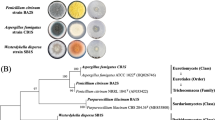Abstract
Poly (butylene adipate-co-terephthalate) (PBAT) has been extensively used in every field of life, but the PBAT hydrolyzing microorganisms had rarely been studied. In this project, the synergistic degradation effect of bacteria identified from the farm soil of Shaanxi village yuan Jia cun was studied. To improve the degradation of PBAT, a co-culture system was made using SUST B1, SUST B2, and SUST B3. It was noted that the synergistic degradation of PBAT days was greater as compared to the monoculture system. Maximum lipase activity was observed after 6 days of incubation, the lipase activity (24.3 U/mL) of the co-culture surpassed the monoculture which was substantially complex as compared to individual bacterium SUST B1 (9.42 U/mL), SUST B2 (10.1 U/mL), and SUST B3 (8.7 U/mL) degrading 26.1% of PBAT. These results were further confirmed using XRD, FTIR, and SEM analysis. The mechanism of PBAT degradation was also studied using LC/MS. PBAT degradation is comprised of numerous phases that generate oligomers, dimers, and monomers. The microorganisms secreted the PBAT-degrading lipase that catalyzes the ester bonds present in the PBAT backbone and convert it into respective monomers like terephthalic acid, 1, 4-butanediol, and adipic acid. Microbes then uptake them to fulfill their carbon need and degrade them. Hence, PBAT bioremediation can be accomplished by a co-culture system. This is the first study to report the synergistic degradation of PBAT in the co-culture system.
Graphical abstract







Similar content being viewed by others
References
Jia H et al (2021) Degradation of poly(butylene adipate-co-terephthalate) by Stenotrophomonas sp. YCJ1 isolated from farmland soil. J Environ Sci China 103:50–58
Li P et al (2020) Characteristics of plastic pollution in the environment: a review. Bull Environ Contam Toxicol 1:3
Haider TP, Völker C, Kramm J, Landfester K, Wurm FR (2019) Plastics of the future? The impact of biodegradable polymers on the environment and on society. Angew Chemie - Int Ed 58:50–62
Silva AB et al (2018) Microplastics in the environment: challenges in analytical chemistry—a review. Anal Chim Acta 1017:1–19
Timbart L, Tse MY, Pang SC, Babasola O, Amsden BG (2009) Low viscosity poly(trimethylene carbonate) for localized drug delivery: rheological properties and in vivo degradation. Macromol Biosci 9:786–794
Kundys A, Białecka-Florjańczyk E, Fabiszewska A, Małajowicz J (2018) Candida Antarctica Lipase B as Catalyst for Cyclic Esters Synthesis, Their Polymerization and Degradation of Aliphatic Polyesters. J Polym Environ 26:396–407
Kasuya K et al (2009) Characterization of a mesophilic aliphatic-aromatic copolyester-degrading fungus. Polym Degrad Stab 94:1190–1196
Arrieta MP, Samper MD, Aldas M, López J (2017) On the use of PLA-PHB blends for sustainable food packaging applications. Materials (Basel) 10:1–26
Kanwal A, Zhang M, Sharaf F, Li C (2022) Polymer pollution and its solutions with special emphasis on Poly(butylene adipate terephthalate (PBAT)). Polym Bull. https://doi.org/10.1007/s00289-021-04065-2
Sukrakanchana L, Sukkhum S, Somyoonsap P (2011) Isolation of bioplastics-degrading bacteria from compost soil in Thailand. pp 252–253
Kanwal A, Zhang M, Sharaf F, Li C (2021) Enzymatic degradation of poly (butylene adipate co-terephthalate) (PBAT) copolymer using lipase B from Candida Antarctica (CALB) and effect of PBAT on plant growth. Polym Bull. https://doi.org/10.1007/s00289-021-03946-w
Ruggero F, Gori R, Lubello C (2019) Methodologies to assess biodegradation of bioplastics during aerobic composting and anaerobic digestion: a review. Waste Manage Res 37:959–975
Massadeh MI, Sabra FM (2011) Production and characterization of lipase from bacillus stearothermophilus. African J Biotechnol 10:13139–13146
Zhang M, Miao Z, Wang L, Lawson T, Kanwal A (2019) Poly(butylene succinate-co-salicylic acid) copolymers and their effect on promoting plant growth. R Soc Open Sci. https://doi.org/10.1098/rsos.190504
Aarthy M, Puhazhselvan P, Aparna R, Sebastian A, Kuppuswami M (2018) Growth associated degradation of aliphatic-aromatic copolyesters by Cryptococcus sp. MTCC 5455. Polym Degrad Stab 152:20–28
Biundo A et al (2016) Characterization of a poly(butylene adipate-co-terephthalate)-hydrolyzing lipase from Pelosinus fermentans. Appl Microbiol Biotechnol 100:1753–1764
Kanwal A, Zhang M, Sharaf F, Chengtao L (2021) Screening and characterization of novel lipase producing Bacillus species from agricultural soil with high hydrolytic activity against PBAT poly ( butylene adipate co terephthalate ) copolyesters. Polym Bull. https://doi.org/10.1007/s00289-021-03992-4
Muroi F et al (2017) Characterization of a poly(butylene adipate-co-terephthalate) hydrolase from the aerobic mesophilic bacterium Bacillus pumilus. Polym Degrad Stab 137:11–22
Barrier V, Properties A, Roy S (2020) Curcumin incorporated poly (Butylene). pp 1–15
Herrera R, Franco L, Rodríguez-Galán A, Puiggalí J (2002) Characterization and degradation behavior of poly(butylene adipate-co-terephthalate)s. J Polym Sci Part A Polym Chem 40:4141–4157
Bradu C et al (2019) Pd-Cu catalysts supported on anion exchange resin for the simultaneous catalytic reduction of nitrate ions and reductive dehalogenation of organochlorinated pollutants from water. Appl Catal A Gen 570:120–129
Kijchavengkul T et al (2010) Biodegradation and hydrolysis rate of aliphatic-aromatic polyester. Polym Degrad Stab 95:2641–2647
Wei D, Wang H, Xiao H, Zheng A, Yang Y (2015) Morphology and mechanical properties of poly(butylene adipate-co-terephthalate)/potato starch blends in the presence of synthesized reactive compatibilizer or modified poly(butylene adipate-co-terephthalate). Carbohydr Polym 123:275–282
Garaleh M, Lahcini M, Kricheldorf HR, Weidner SM (2009) Syntheses of aliphatic polyesters catalyzed by lanthanide triflates. J Polym Sci Part A Polym Chem 47:170–177
Author information
Authors and Affiliations
Corresponding author
Additional information
Publisher's Note
Springer Nature remains neutral with regard to jurisdictional claims in published maps and institutional affiliations.
Rights and permissions
Springer Nature or its licensor (e.g. a society or other partner) holds exclusive rights to this article under a publishing agreement with the author(s) or other rightsholder(s); author self-archiving of the accepted manuscript version of this article is solely governed by the terms of such publishing agreement and applicable law.
About this article
Cite this article
kanwal, A., Zhang, M. & Sharaf, F. Synergistic degradation of PBAT poly (butylene adipate-co-terephthalate) co-polyesters using a bacterial co-culture system. Polym. Bull. 81, 2741–2755 (2024). https://doi.org/10.1007/s00289-023-04849-8
Received:
Revised:
Accepted:
Published:
Issue Date:
DOI: https://doi.org/10.1007/s00289-023-04849-8




